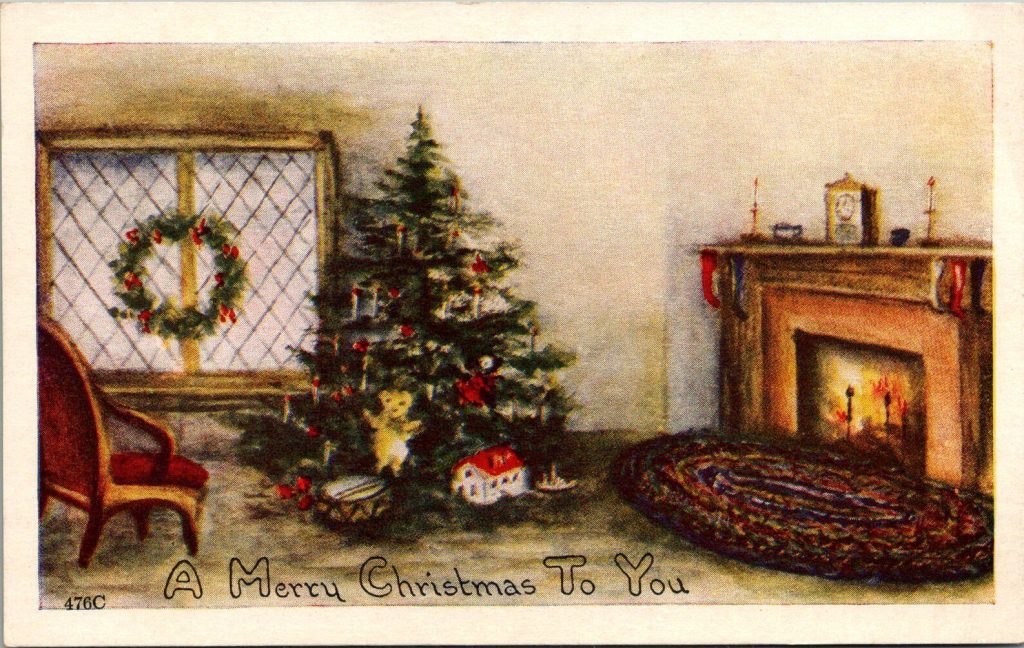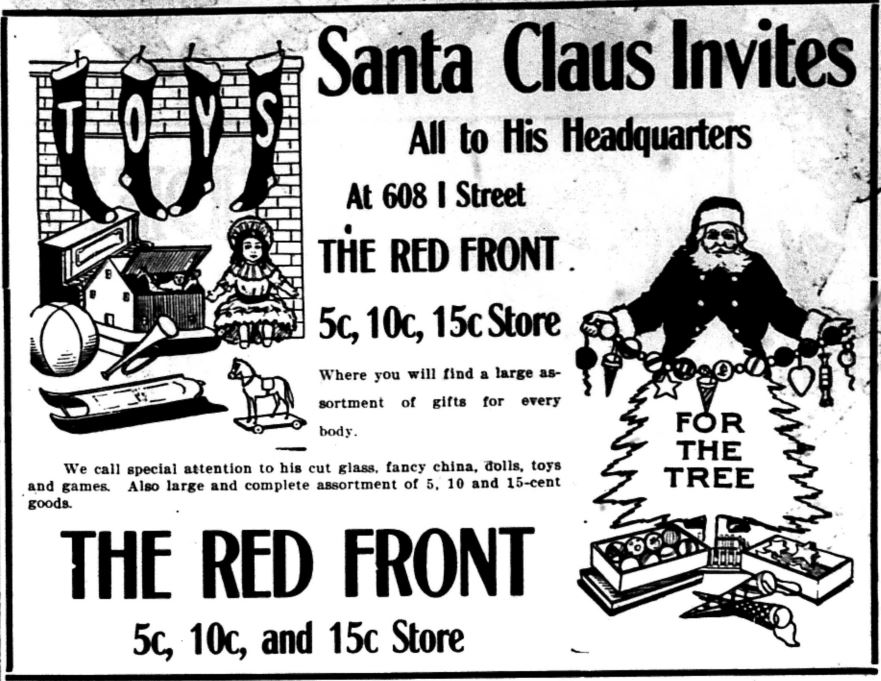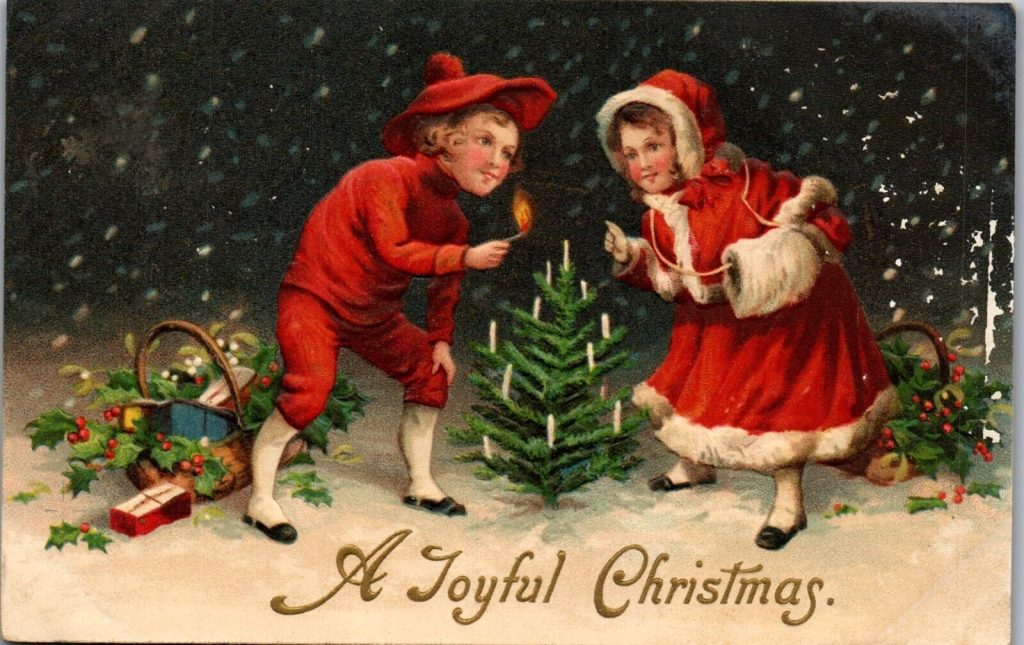Christmas trees were popular at the turn of the 20th century America. German immigrants brought the tradition with them, but trees did not become widespread until the 1840s, popularized by Queen Victoria’s celebrations with her German husband Prince Albert and their large family. In our Grays Harbor history, Christmas trees were so much more than an just an evergreen.

Christmas Tree Parties in Grays Harbor
Christmas trees in the early 20th Century were different than today. Chopped down and brought inside very close to Christmas Day, the trees were loaded down with candles and unwrapped presents. Other gifts were piled around the tree.
Christmas tree displays tempted people into local stores. The Red Cross Pharmacy had a “revolving Christmas tree” in their window to attract people inside in 1906. “Bring all the little folks to see our beautiful illuminated Christmas tree and dolls and toys,” said Livingston’s department store in 1911.
But a “Christmas Tree” could also mean a type of holiday party. After a program of music, readings and recitations, gifts from the tree would be distributed to guests, usually children, often by Santa Claus himself! Sometimes there would be games and refreshments. Children often performed at these events. Gifts were usually fruit, nuts, candy and toys.
Most churches, as well as many clubs and other organizations, held annual “Christmas Trees” before the holiday and even on Christmas Eve or Day. “The church was handsomely decorated,” wrote the Aberdeen Herald about an 1894 party held by the Methodist Church’s Sunday school, “on either side of the choir loft stood a Christmas tree, laden with gifts from parents and friends, while in the center stood a chimney, the bricks of which were boxes of candy that Santa Claus distributed to the children.” After a festive musical and literary program, a young Santa Claus entertained students with a recitation before Santa himself arrived to distribute presents.

Communities both big and small held “Christmas Trees” of their own. One hundred attended a dance and “Christmas Tree Party” at Joshua Simmons’ home at Garrard Creek in 1895. Humptulips held theirs at the Newbury Hotel in 1897. Writing about a “Christmas Tree” event to the Aberdeen Herald in 1914, “World Traveler and Evangelist” J.E. Naylor enthused that, “These children and people, young and old, on the Copalis sands certainly know how to speak and sing.” The community had raised $22, enough for everyone present to receive gifts and a bag of candy.
People also held “Christmas Tree” parties for friends and relatives. Clubs organized small “Christmas Tree” gatherings of their own for members and their families. The German Society was one for sure! In 1911, the Swedish Lodge of Good Templars sponsored a party at the AOUW hall, a program and “after the Christmas tree had been stripped of its presents” they cleared the floor for dancing.

Schools held “Christmas Tree” parties for students. In 1905, Mrs. F.K. Van Tassel’s private primary school organized a darling party. After a short program by students, “came the unloading of the Christmas tree which stood in the front room adjoining the schoolroom. Toys and candies, tinsel and glitter, dolls and harmonicas, drinking cups and stationary outfits were brought from the branches of that little tree, which, although necessarily inexpensive proved a great delight to the children.”
Grays Harbor Holiday Charity
“Christmas Tree” parties were also intended to help children in need. The Salvation Army and Pythian Sisters had annual charity Christmas trees, but Aberdeen Elks and Hoquiam Elks were by far the largest. Children under 12 could come throughout Christmas day and receive gifts, handed out by Santa Claus. There were two trees in 1909, one with presents for boys and the other for girls. Gifts included food and clothing, as well as toys. In 1915, 500 kids came to the Hoquiam Elks’ event.

Christmas Tree Safety
Lighting trees by candle was highly dangerous and people were urged to be very careful lighting the tree and removing presents, which could knock off candles. The tree, they warned, could easily become a torch and burn down the house—or “so say the fire fighters,” proclaimed the Aberdeen Herald in 1905, “who every year have their own Christmas spoiled by the neglect of these very obvious precautions.”
Christmas Trees: Bringing the Grays Harbor Community Together
As seen, Christmas trees brought people together. It was small wonder that in 1913, the Aberdeen Parent-Teacher Association sponsored a municipal “Christmas Tree” on the lawn of the public library on Christmas Day. Fifty feet tall, it was set up by the fire department and electrically lit by the Grays Harbor Railway and Light Company. About 2,000 people attended the evening event. There was a music program under the portico. Bags of candy were given away to children under age 15.
While distributing presents hanging from Christmas trees may be a thing of the past, these trees still seem to have a magic of their own. But holiday cheer isn’t limited to trees. As the poem “Save a Little Christmas Cheer,” printed in the Aberdeen Herald, said in 1911, they “make everyone happy, just as happy as can be. But don’t hang all your presents on the Christmas tree.” Help spread some cheer this year. Happy holidays!











































